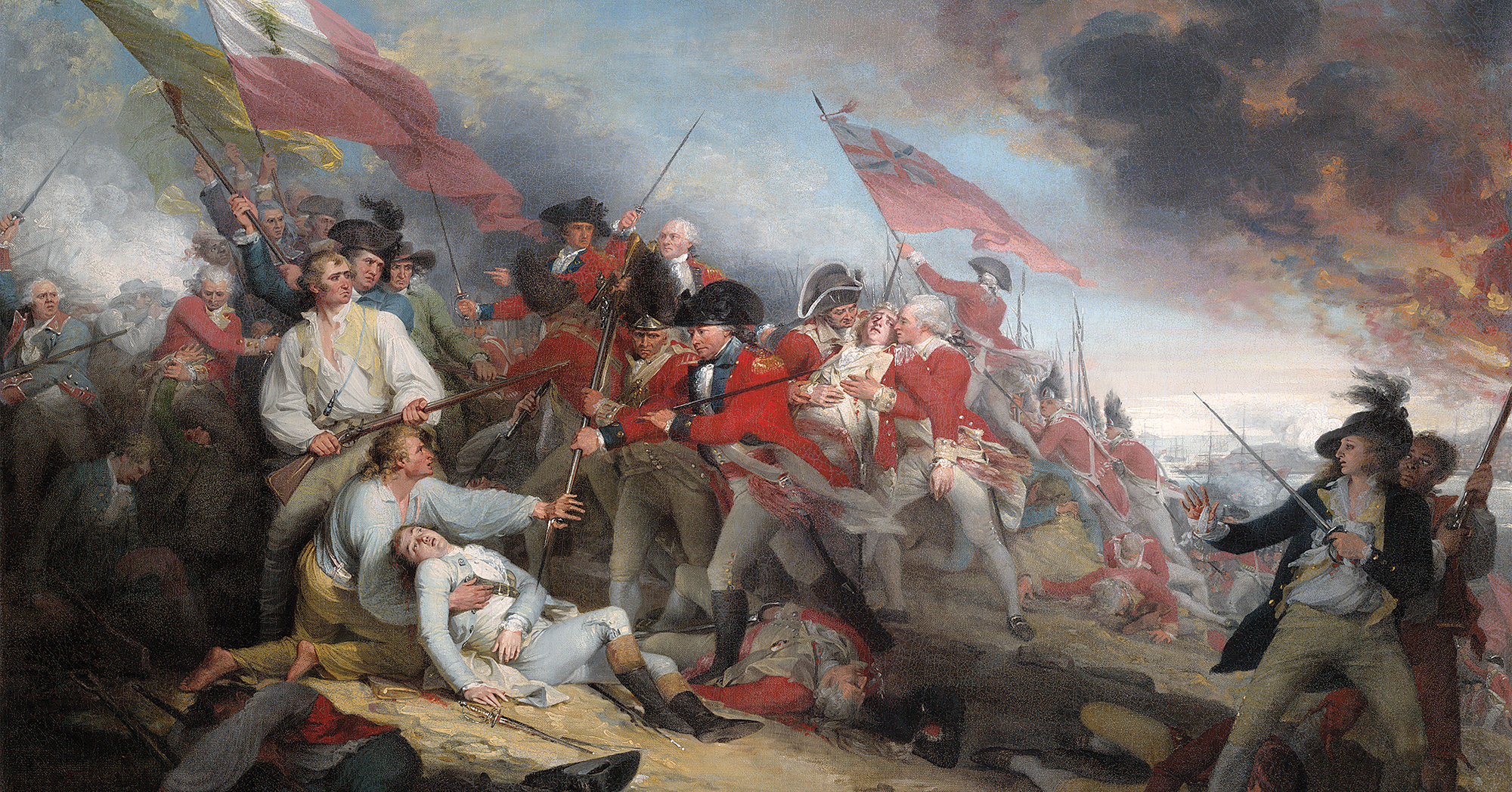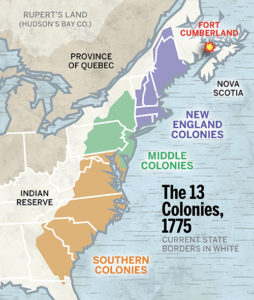 By the mid-18th century American Indians in New England had been subjected to a century and a half of unsolicited hardship—succumbing to unfamiliar diseases brought by European colonists, increasingly dislodged by encroaching settlers, hunted down by soldiers, and used as pawns in the struggle for dominion between Britain and France. The latter ostensibly culminated with the end of the French and Indian War in 1763, though anyone believing that marked the end of conflict on North American soil was in for a rude awakening. War drums were soon beating once again, auguring a conflict that would again force the region’s Indians to choose sides.
By the mid-18th century American Indians in New England had been subjected to a century and a half of unsolicited hardship—succumbing to unfamiliar diseases brought by European colonists, increasingly dislodged by encroaching settlers, hunted down by soldiers, and used as pawns in the struggle for dominion between Britain and France. The latter ostensibly culminated with the end of the French and Indian War in 1763, though anyone believing that marked the end of conflict on North American soil was in for a rude awakening. War drums were soon beating once again, auguring a conflict that would again force the region’s Indians to choose sides.
Wags were already referring to Nova Scotia as the ’14th colony.’ It was a valid concern, made even more pressing by the rising anger of the region’s Indian tribes
The end of the French and Indian War was a particularly perplexing time for Indians in northern New England and Nova Scotia. The signing of the 1763 Treaty of Paris ceded much of what had been New France to the British, and King George II’s subsequent Royal Proclamation that year set aside the largely uncolonized territory west of the Appalachian Mountains as an Indian reserve, off limits to settlement—at least for the time being. As for the land between the Appalachians and the Atlantic Ocean, the Indians were told it was the domain of the British Crown. But the people who had been there before the Europeans had never considered themselves subjects of either European power, merely allies, thus the treaty signed by the French and British meant nothing to them.
With the end of the war came a tide of British colonists, many of whom pushed farther north and inland. Responding to a plea for settlers from Charles Lawrence, governor of the British province of Nova Scotia—a region spanning present-day eastern Quebec, the Maritime Provinces of New Brunswick, Nova Scotia, Prince Edward Island and far northern Maine—8,000 so-called “New England Planters” ventured north. (At the time most of Maine comprised a district within the sprawling Province of Massachusetts Bay.) French Nova Scotians not expelled by the British before or during the war either learned to live under Crown rule, moved west to Quebec—where, though under British rule, the French remained the majority—or relocated south to French Louisiana. A decade later came the American Revolution, and suddenly the newcomers in Nova Scotia were forced to decide where their loyalties lay.
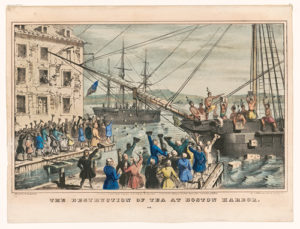
Fed up with taxation without representation in Parliament, waves of angry New Englanders were on the prod. In Boston on Dec. 16, 1773, a band of colonists—some disguised as Indians—had boarded British ships and dumped an entire shipment of tea into the harbor. Parliament responded with the 1774 Coercive Acts (soon derided by colonists as the “Intolerable Acts”), largely stripping the Massachusetts rebels of self-rule. That fall at the meeting of the First Continental Congress in Philadelphia, delegates in turn called for a boycott of trade with Britain and its colonies (including Canada) until George III addressed their grievances. While the embargo had a trifling effect in Britain, it had a severe impact on Nova Scotian farmers and merchants, who had developed a robust trade with the colonies to the south. Within months the American economic pressure led to shortages of food and goods throughout the Canadian maritime region. To further thwart the flow of supplies and goods overland from the north to Loyalists and British troops stationed in New England, the Patriots agitating for a break with the Crown sent privateers to raid and destroy ports in Nova Scotia.
Despite the economic hardship—or perhaps due to it—many Nova Scotians initially sympathized with their rebellious neighbors to the south. When news of the June 17, 1775, Battle of Bunker Hill reached the settlements, for example, supporters of the cause procured a carriage drawn by six horses and, waving a flag of liberty, proclaimed the news far and wide.
Demographics can help explain the stir of emotions. Estimates put the total non-Indian population of Nova Scotia in 1775 at just under 20,000 people, three-quarters of whom hailed from Massachusetts, Connecticut and Rhode Island. Any French who remained were at best ambivalent about the conflict to the south, as were German immigrants, while Irish immigrants actively assisted the rebels. Only a small percentage of Nova Scotians were Loyalists from England and Scotland. The statistical skew prompted provincial Governor Francis Legge to express his concern in a letter to London-based colonial secretary Lord Dartmouth. Would those residents with New England roots raise arms and defend the province against possible attack by the Americans? Wags were already referring to Nova Scotia as the “14th colony.” It was a valid concern, made even more pressing by the rising anger of the region’s Indian tribes.
In the coming battle for the northern frontier, the British and Americans alike recognized the military potential of the Indians—known in Canada as the First Nations. Leaders on either side courted their favor. If the tribes couldn’t be convinced to join the fight, the thinking went, then perhaps they could be persuaded to remain neutral.
Despite what they had been promised or may have hoped, nothing would remain the same for the region’s Indians, no matter which side they joined
Among the sympathetic Nova Scotians acting on behalf of the American colonists was John Allan. Born in Edinburgh, Scotland, on Jan. 13, 1746, he was the son of a British army officer who moved his family to Nova Scotia in 1849 and was presumably rewarded with a land grant after the French and Indian War. Educated in Massachusetts, Allan returned to the family lands in Nova Scotia where he became involved in local politics and made his living as a farmer and a merchant, turning a tidy profit from trade with New England.
Others might have been content with their wealth and station and cozied up to British authorities, but given his Boston education, trade connections and neighbors with ties to New England, Allan sympathized with the Patriots and vigorously defended their cause to all who would listen. It was Allan’s friends who blazed around the countryside in a carriage to hurrah the uprising at Bunker Hill.
As a prominent citizen and member of the Nova Scotia House of Assembly, his opinions naturally attracted attention, soon inviting censure from provincial authorities. When Allan refused to be silent, the government charged him with treason. So, in August 1776 he fled across the border to Machias, in the District of Maine.
Like many other Patriot leaders, Allan paid dearly for his beliefs. In his haste to flee Nova Scotia, he had to leave behind wife Mary and their five children. As the rebellion spread, the British burned his Halifax home to the ground. Mary was later imprisoned and interrogated, the children sent to live with a relative. Regardless, the Scottish-born firebrand persisted.
Allan believed the key to defending the northern frontier lay in securing the active participation—not merely the neutrality—of the region’s Indians. Before fleeing Nova Scotia he had met with representatives of the Micmac and Maliseet nations, whom he thought would be valuable allies to the colonial rebels.
Those two powerful nations, together with the Passamaquoddy, Abenaki and Penobscot peoples, comprise the Wabanaki Confederacy—a regional alliance whose origins in Nova Scotia stretch back at least to the arrival of the first French settlers in the early 17th century. Influenced by the teachings of the Jesuits, they had long befriended the French and fought alongside them in the previous war. Though the nations had subsequently signed treaties of peace and friendship with the victorious British, they still regarded the encroaching newcomers as outsiders. As the colonists were revolting against the Crown, the Indians largely empathized with them. Given the complex relationships and lack of trust on all sides, the nations tried their best to remain neutral in this latest struggle. Unfortunately, despite what they had been promised or may have hoped, nothing would remain the same for the region’s Indians, no matter which side they joined.
In the spring of 1775, as Patriots from Massachusetts to Georgia banded together to battle the British, men and supplies funneled southward out of the remote District of Maine, rendering the northern frontier all but defenseless. Left mainly to their own devices, the small contingent of remaining settlers and a handful of Indian allies were expected to hold British forces in the Canadian Maritimes at bay. Such would be a daunting task for even an established fighting force, let alone a group of poorly armed farmers.
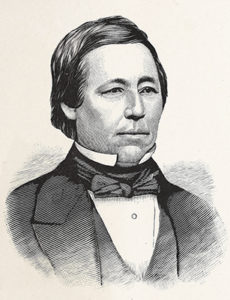
Yet British authorities in Nova Scotia had grown increasingly nervous the previous winter. Governor Legge, for one, was convinced that the majority residents with New England roots were plotting against the government and inciting other locals into raising arms against the British. He was partly right. Among the dissenting New Englanders was Jonathan Eddy. Born in Norton, Mass., circa 1726–27, Eddy had fought for the British in the colonial militia during the French and Indian War before answering Governor’s Lawrence’s plea for planters and moving to Nova Scotia in 1763. Like Allan, Eddy prospered, dabbled in local politics and served in the Nova Scotia House of Assembly. Openly supportive of the Patriot cause, he was forced into hiding but continued to foment rebellion in the province.
As the American Revolution heated up in early 1776, he ventured south to meet with such Patriot leaders as George Washington and Sam Adams, pressing them to mount an invasion to “liberate” Nova Scotia. While failing in that effort, Eddy did secure a commission as a colonel in the Continental Army and a promise from the Massachusetts Provincial Congress of weapons, ammunition and other supplies for any force he was able to raise. He immediately set out for Machias, where Patriot fervor ran high.
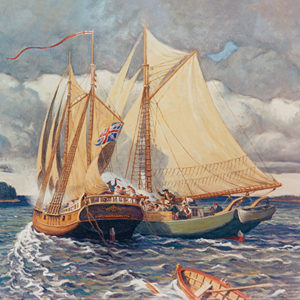
On June 12, 1775, just two months after the opening clashes at Lexington and Concord, Mass., the first naval battle of the war took place off Machias. Amid the Siege of Boston the British had sent two Loyalist merchant ships north to trade for needed lumber to build barracks. To ensure the deal went through, the British also dispatched the armed schooner Margaretta, which sat offshore within firing distance. Offended and unwilling to help the British, townsmen instead seized one of the merchant ships and used it to chase down the slower warship, which they captured and turned over to the Provincial Congress. For the duration of the war Patriot privateers out of Machias would continue to harass, capture and sink British ships.
Eddy, who had resolved to besiege Fort Cumberland in central Nova Scotia, arrived in town in August 1776 seeking volunteers but was able to recruit only 20 men. Hoping to pick up more along the way, he was preparing to sail north when Allan arrived in harbor and tried to dissuade his associate, to no avail. Making his way up the Nova Scotia coast, Eddy picked up seven men in Passamaquoddy Bay. Sailing up the St. John River to the New England planter community of Maugerville, he recruited 27 settlers and 19 Maliseets. From there the growing war party sailed up the Bay of Fundy in whaleboats and canoes to Shepody, where they caught the small British outpost by surprise.
After picking up a handful of willing Acadians at Memramcook, Eddy marched overland to Sackville, about 5 miles west of Fort Cumberland. By then it was early November, and his force had swollen to about 180 men. The fort was garrisoned by some 200 Loyalist troops under the command of British army Lt. Col. Joseph Goreham, who had put a price on Eddy’s head.
On the evening of November 6 Eddy’s men managed to seize a loaded supply sloop docked out of sight of the fort, taking 13 prisoners. The next morning Goreham, unaware of its capture, sent a 30-man work party down to the sloop. They, too, were taken. Added to the loss of the Shepody outpost, Eddy had captured a full quarter of the garrison and most of its supplies.
On November 10 he sent to Goreham an ultimatum to surrender, which the plucky British commander answered in kind. Things went downhill for Eddy from there. Though he had no artillery or siege equipment, the colonel took the 80 of his men not standing watch or guarding prisoners and laid siege to the fort. He found it stronger than he had imagined. Twice repulsed, Eddy resorted to a blockade. Meanwhile, British authorities had gotten wind of Eddy’s operation, and on November 29 reinforcements landed and drove off the attackers, ending the siege.
Eddy returned to Machias, where he managed its defense through war’s end.
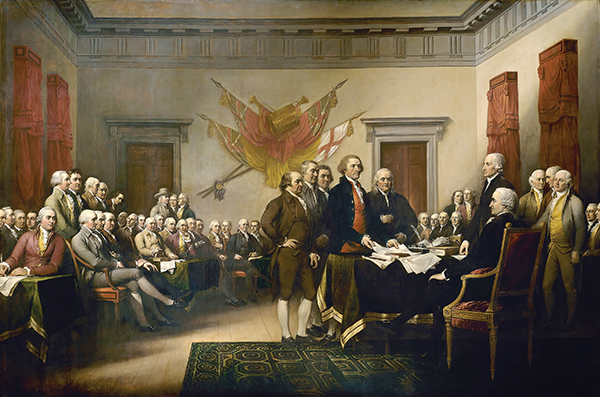
That summer had brought promising signs of a thaw in American relations with the First Nations. On July 19, 1776, scarcely two weeks after the signing of the Declaration of Independence, representatives of the fledgling United States had penned the nation’s first foreign treaty—and first treaty with Indians—in Watertown, Mass. Among other provisions, the Treaty of Watertown called for the Micmac and Maliseet tribes and the United States to aid one another against any enemy, including Great Britain; the tribes to refrain from assisting British troops or subjects or trading with them as long as hostilities continued; the tribes to furnish General Washington with 600 warriors (“or as many as may be”); the tribes to urge the Passamaquoddy and other allied nations to also furnish and supply men for the Continental Army; Massachusetts to establish a trading post at Machias for the tribes; and the tribes to renounce all former treaties with any other power. (Though Micmacs at the time did not universally agree to the treaty, the present-day nation does still honor its terms, allowing its citizens to join the U.S. military.)
Meanwhile, Allan had been hard at work. In October he attempted to secure aid in Boston for his Indian allies but came up empty due to pressing domestic needs. On November 29—the day Eddy’s siege of Fort Cumberland ended in failure—Allan headed to Pennsylvania to meet with Washington, who was hard-pressed by the British and about to go into winter quarters at Valley Forge. He, too, could offer little help. Not letting the dust settle, Allan moved on to meet with the Second Continental Congress, which had fled to Baltimore, one step ahead of the British advance on Philadelphia.
Received by the delegates on Jan. 1, 1777, he gave a full accounting of matters on the northern frontier. Impressed by his knowledge of and feeling for the tribes, they appointed him superintendent of Indians in the Eastern Department of the Continental Army at the rank of colonel. They also gave him the go-ahead to establish a military presence along the St. John River and recruit Maliseets and settlers to the Patriot cause. On the delegates’ authority, he applied to the Massachusetts General Court to raise 3,000 men for the campaign. If he could win over enough Nova Scotians, Allan hoped to launch another assault on the British supply base at Fort Cumberland.
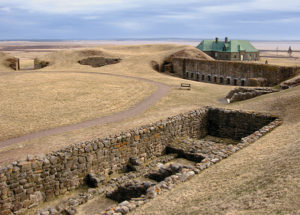
Establishing his headquarters in Machias, Allan was able to recruit just under 100 men, including allied Indians, before setting out for Nova Scotia in a flotilla of whaleboats and birch canoes in late May. Reaching the mouth of the St. John on June 2, Allan left 60 men to guard the approach, then made his way upriver with the rest of his party to open negotiations with the Maliseets. Once again, however, the British got wind of a Patriot operation in their midst, and three weeks later British warships landed troops at the mouth of the St. John. Leading the retreat upriver and back down an old canoe route, Maliseet Chief Ambroise Saint-Aubin managed to return Allan’s party home and bring nearly 500 of his people to Machias and safety—or so they thought.
In retaliation for Allan’s attack and to discourage any further incursions into Nova Scotia, a squadron of five Royal Navy warships under Commodore Sir George Collier planned a pre-emptive strike against Machias. Arriving at the mouth of the Machias River on August 13, two of the British ships moved upriver toward the settlement, planning to land a contingent of Royal Marines. Fortunately for the Patriots, Eddy had received advance warning of the attack. He had his militiamen place a log boom across the river and set up several defensive positions along its banks. The barrier and withering musket fire were enough to convince the Marines to remain aboard that night.
Waiting with the militiamen to spring the trap the next morning were Allan and his tribal allies, including the Maliseets, Penobscots and Passamaquoddies under Chief Francis Joseph Neptune. Though the British managed to breach the log boom, land some Marines and torch a few outbuildings, no sooner had they dropped anchor within range of the settlement than they abruptly broke off their attack and sailed for home. Veterans of the battle credited the Indians’ expert marksmanship and “hideous yells” for undermining British resolve and morale. Chief Neptune himself made a long-range musket shot that toppled a red-coated officer into the river.
Machias was not attacked again. However, neither would Washington permit another military expedition into Nova Scotia. Like Eddy, Allan would sit out the war in Maine. Their shared dream of leading an invasion of their adopted province was dead.
Like Eddy, Allan would sit out the war in Maine. Their shared dream of leading an invasion of their adopted province was dead
In the summer of 1779, in a sad footnote to the frontier saga, Micmac warriors sworn to the Patriot cause plundered the homes of British settlers in Maugerville, prompting a Royal Navy expedition to subdue the Indians. Sailing upriver in a U.S.-flagged prize ship to lull the Indians into complacency, the British crew captured more than a dozen Micmacs as they came to greet their “trusted American friends.” The captives were sent to prison in Quebec.
Seeking their release, Micmac Chief John Julien visited Michael Francklin, the Crown-appointed superintendent of Indian affairs in Halifax—John Allan’s counterpart in Nova Scotia. Seeking a permanent end to the uprisings, Francklin agreed to turn over the hostages, on several conditions. Promising the Indians supplies, trading privileges and an end to British interference in their affairs, he in exchange got the Micmacs to sign a treaty vowing to protect British settlers in the province, turn over any remaining troublemakers and above all have nothing more to do with Allan. It was a repudiation of the 1776 Treaty of Watertown, and it worked to keep the peace north of the frontier line. MH
U.S. Army veteran Dana Benner holds a master’s degree in heritage studies. He teaches history, political science and sociology at the university level. For further reading Benner recommends Unsettled Past, Unsettled Future, by Neil Rolde.

